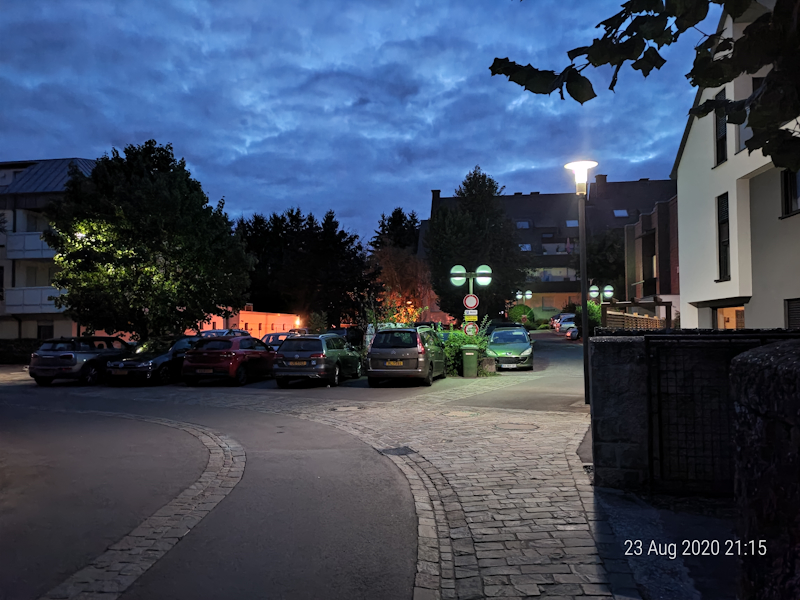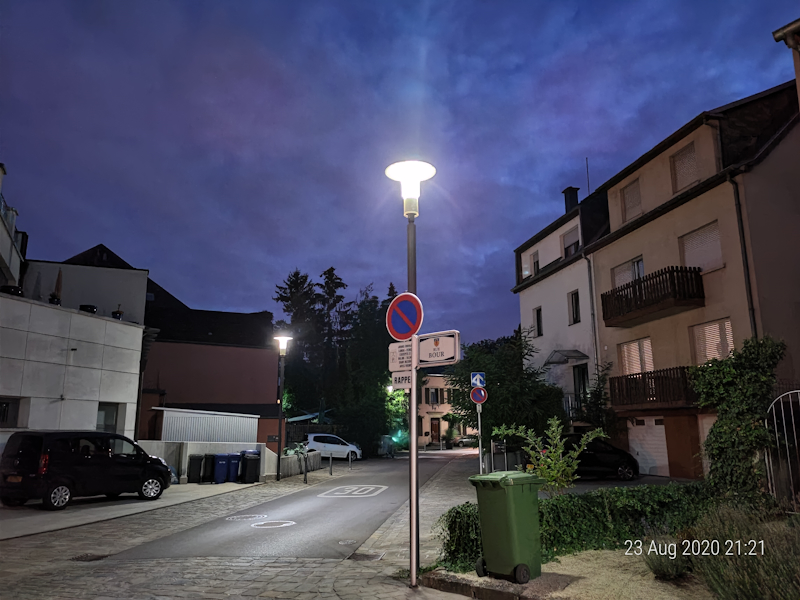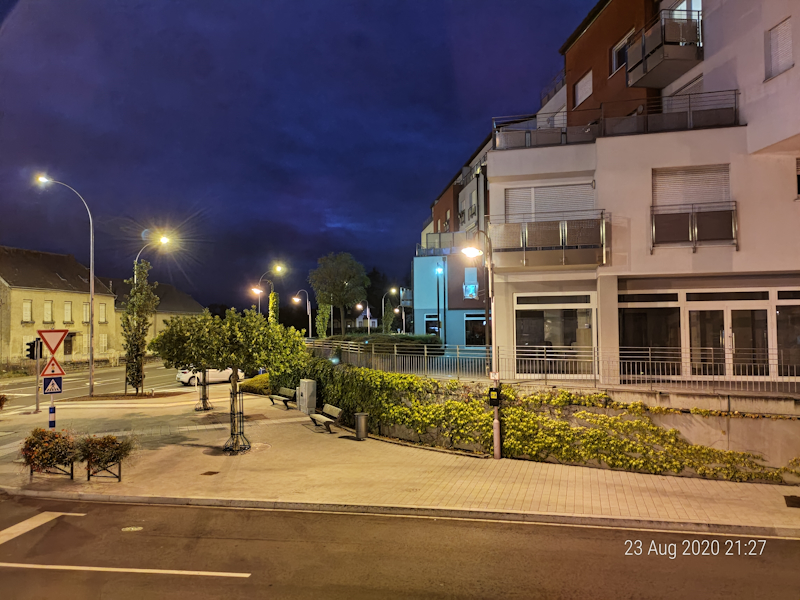The ASUS ZenFone 7 Pro Review: The Triple Flip-Camera
by Andrei Frumusanu on September 1, 2020 3:00 AM EST- Posted in
- Mobile
- Asus
- Smartphones
- ZenFone 7
- ZenFone 7 Pro
Camera - Low Light Evaluation
Low-light capture of the ZenFone 7 is actually an interesting topic as we had seen ASUS’s night mode implementation in the ROG3 perform quite well when it comes to its algorithms for computational photography, albeit being handicapped by the lack of OIS.
The ZenFone 7 Pro does have OIS so we should see quite improved low-light photography results. It’s important to keep in mind though that the results posted here are only representative of the Pro variant, as the standard base model doesn’t feature OIS, with results likely much worse than what’s presented here.

[ Zenfone 7 Pro ] - [ ROG Phone III ]
[iPhone 11 Pro ] - [Galaxy S20+(E) ]
[ Pixel 4 ] - [ X-T30 ]
The first scene is actually quite impressive as the ZenFone is able to achieve a quite excellent results that is very competitive and easily beats the shots of the iPhone 11 and the S20’s. The OIS allows the phone for a longer exposure compared to the ROG3 and to fill in more of the shadows of the scene.
The ultra-wide also benefits from night-mode and the newer sensor, however the result remains quite blurry compared to what the S20 is able to achieve.
The telephoto module in low-light isn’t very good – in this instance it didn’t even manage to focus on the subject.

[ Zenfone 7 Pro ] - [ ROG Phone III ]
[ iPhone 11 Pro ] - [ Galaxy S20+(E) ]
[ Pixel 4 ] - [ X-T30 ]
The next shot also is very much in favour of the ZenFone 7 Pro as it’s extremely comparable to the Pixel 4 picture and amongst the best results in the set.
The ultra-wide here unfortunately didn’t do well as it’s completely blurry.

[ Zenfone 7 Pro ] - [ ROG Phone III ]
[ iPhone 11 Pro ] - [ Galaxy S20+(E) ]
[ Pixel 4 ] - [ X-T30 ]
When there’s a bit more light, the ZenFone also fares extremely well and it’s again quite surprising to see just how similar the ASUS device compared to the Pixel 4. The ZenFone actually wins out in details, however both phone’s colour temperatures are wrong as the iPhone is closest to the actual colour of the sodium lamps on the street.
The telephoto module here is somewhat usable albeit it’s very noisy. Night mode doesn’t work on this module.

[ Zenfone 7 Pro ] - [ ROG Phone III ]
[ iPhone 11 Pro ] - [ Galaxy S20+(E) ]
[ Pixel 4 ] - [ X-T30 ]
The ROG3 already had done quite well in this scene before, and the ZenFone 7 Pro produces even sharper image with extremely good handling of the highlights and overall processing. I would even go as to say that it’s the best performing device amongst the comparison phones.

[ Zenfone 7 Pro ] - [ ROG Phone III ]
[ iPhone 11 Pro ] - [ Galaxy S20+(E) ]
[ Pixel 4 ] - [ X-T30 ]
Again, it’s the OIS which makes the difference to the ROG3 as in lower light conditions the ZenFone 7 Pro manages a 2.6x higher exposure through a combination of slower shutter speeds as well as a higher ISO level.
I would again as to say it’s amongst the best performers here as it manages to still retain a lot of detail, and most importantly it also got the colour temperature right.

[ Zenfone 7 Pro ] - [ ROG Phone III ]
[ iPhone 11 Pro ] - [ Galaxy S20+(E) ]
[ Pixel 4 ] - [ X-T30 ]
Further in extreme low-light, the ZenFone 7 Pro continues to impress with its superior night mode, able to retain a ton of detail and more dynamic range than other phones.
Low-Light Conclusion - A Surprise Top Contender
Overall, the ZenFone 7 Pro really surprised me in terms of its low-light capture ability. ASUS’s Night Mode showed potential on the ROG3, and the addition of OIS really augments the whole camera system to a level that’s not only competitive with other smartphones on the market, but more often than not it actually beats them when it comes to detail and exposures.
The ultra-wide isn’t as well tuned as the main camera, and here it mostly loses out to Samsung’s night mode implementation. The telephoto module is largely not usable in low-light.










31 Comments
View All Comments
JfromImaginstuff - Tuesday, September 1, 2020 - link
Seriously, doing away with the headphone jack in exchange for 5G. Might as well go with Samsungs.yu - Tuesday, September 1, 2020 - link
Yeah they say 5G antennas are small, sometimes they omit the fact that you need more than a dozen of them.melgross - Tuesday, September 1, 2020 - link
You need from three to five, depending on whether you’re using sub mm bands or not, not dozens.Quantumz0d - Tuesday, September 1, 2020 - link
It's 100% b.s LG V60 and Sony Xperia Mark II both of them are 5G and LG even has full U.S band support with mmWave technology as well and has a superior Audio performance from the standalone RFI shielded high end ESS9219 DAC chipset (ESS9218P was being featured in LG phones from V30 and up) and both of them have IP68 rating along with Qi charging too. The fact that Note 20 gets a full blown Silo for the S-Pen makes so fucking ground for these lying bastards. Removing jack is saving pennies and forcing them to buy accessories which also die out due to the Li-Ion technology.5j3rul3 - Tuesday, September 1, 2020 - link
Can anyone describe how to understand the ∆E ITP and ∆E ITP LC value?I did use ∆E 2000 with Gamma 2.2 for long time, but even searching in google, the data just saying about Rec.2100, EOTF, PQ, HLG and ITU-R....
I knew ∆E ITP is a part of Rec.2100 HDR...but, the info I really want to know is the relationship between ∆E ITP (LC) and real world.
∆E 2000 < 1:Great and almost perfect
∆E 2000 < 2:so hard to see the difference and it's good enough for professional users
∆E 2000 < 3:good for general users
∆E 2000 < 5:ok for general users but still has noticebal color difference
∆E 2000 > 7:esay to see the color difference
Can ∆E ITP and ∆E ITP LC use those standards (0 ~ 1 ~ 2 ~ 3 ~ 5 ~ 7 ~)?
Andrei Frumusanu - Tuesday, September 1, 2020 - link
dE ITP is a new standard that takes into account more modern reproduction formats such as HDR. Generally ITP is a little more sensitive than the 2000 standard to colour deviations: https://kb.portrait.com/help/about-deltae-edE ITP LC as I use it in the new reviews is simply a luminance compensated value, meaning that the error value ignores the luminance error and only looks at hue and chromacity. This makes sense for example in this review here as the ZenFone is targeting a 2.4 gamma by default, however our measurements are against a 2.2 gamma target. So the dE LC values are always going to be lower since it ignoers that part of the colour inaccuracy.
Under dE ITP of 1 it's imperceptible, under 3 it becomes acceptable when not viewed next to each other, and over 10 means it's horribly wrong.
5j3rul3 - Thursday, September 3, 2020 - link
Thank you @Andrei, the reply is really helpful!!!Now I can read the Calman's color calibration charts and info well based on that very useful knowledge, and easy to judge which device can provide great display quality.
Two more things I was wondering in this article:
1. The devices that Anandtech had reviewed such as Mate 20, iPhone XR, Xperia 1 even Surface Pro or XPS13, will get the updated display quality review based on the new delta ITP (LC) standard?
2. ASUS ZenFone 7 Series has a telephoto camera that has very similar spec to HUAWEI and Honor devices' (OV8856, 1/4.4", 1 um, F2.2, 80 mm{, OIS}, with terrible PDAF). It brings 3X Optical Zoom to ASUS smartphone first time and I'm expecting the 3X OZ camera can shows on ZenFone 7 Pro's review. This will be interesting if we have a comparison between ZF7P, 1+7P, M30P, P30 those who having a 3X OZ camera.....is there any opportunity to see this kind of comparison?
in the end, I really thank to AnandTech's great quality reviews!!!
shabby - Tuesday, September 1, 2020 - link
"This is something that ASUS actively acknowledges as being a deliberate design choice so that that they could fit in more components and a larger battery"Did they forget about the headphone jack?
drexnx - Tuesday, September 1, 2020 - link
>made phone huge for more componentsoh yeah we couldn't throw the 3.5mm jack in there, not enough room. The 5 gees, you know, they take up too much space.
Hamm Burger - Tuesday, September 1, 2020 - link
I thought that the unexpectedly low battery life might be because this phone did mm-wave 5G. Bit no: having dug up the specs, the highest 5G frequency band it can handle is 3.3–4.2GHz.